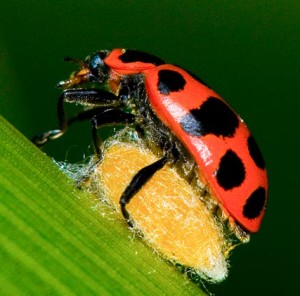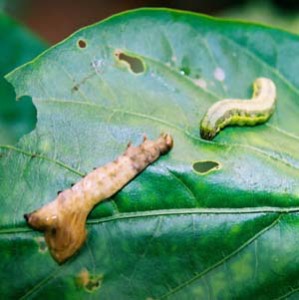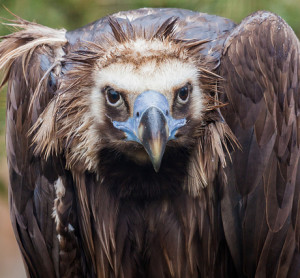“Twitter provides us with a wonderful platform to discuss/confront societal problems. We trend Justin Bieber instead.”—Lauren Leto
 A few months ago, National Geographic ran an article about parasitic creatures that turn other species into real-life zombies in the animal world. Since this is a busy week for me and many other Americans, I decided to make my life easy and blatantly plagiarize – I mean deftly summarize – that article in my own inimitable style. And as always, I’m sure that I’ll have some observations of my own that I won’t be able to keep to myself – perhaps including my own theory that there is already a species known to do this to humans, although I’m playing fast and loose with the term “species” in this case.
A few months ago, National Geographic ran an article about parasitic creatures that turn other species into real-life zombies in the animal world. Since this is a busy week for me and many other Americans, I decided to make my life easy and blatantly plagiarize – I mean deftly summarize – that article in my own inimitable style. And as always, I’m sure that I’ll have some observations of my own that I won’t be able to keep to myself – perhaps including my own theory that there is already a species known to do this to humans, although I’m playing fast and loose with the term “species” in this case.
(Note: Actually, now that I’ve finished this, I think you might want to go read the original article before continuing. It turns out that I had a lot more to say about some of the implications of the research into this topic than I expected. But if you don’t want to, that’s okay. I think I’ve done a fairly decent job of including the most salient points here.)
The tiny, harmless, adorable little ladybug, with its stunning red body and black polka dots, is probably the most beloved of all bugs. Even most children who would rather eat liver and Brussel sprouts than touch anything with more than four legs will happily let one of these inoffensive little creatures crawl around in their hand. But this charming little creature is, in reality, a fierce and voracious predator, albeit a good one from our perspective. One ladybug can devour thousands of garden-wrecking aphids during its life, so we have more practical reasons than just their cuteness to love these little beetles.
There is another species that also loves them: the wasps known officially as Dinocampus coccinellae. No bigger than a grain of rice, these nasty little critters manage to lay their eggs inside ladybugs by jabbing their stingers into the ladybug’s belly and injecting them with their egg as well as a mixture of chemicals. Once the egg hatches, the larva feeds on the fluids inside of the ladybug’s body, but remarkably, throughout this ordeal, the ladybug goes on about its business as if nothing is wrong. It keeps on eating aphids while the parasite within feeds on its digested prey. Once the larva grows big enough, it wriggles out of the ladybug’s body, but it’s not done with her yet. That’s when the story gets really interesting as the mind control portion of the saga kicks in.
 Once it has left its former host, the wasp larva wraps itself in a cocoon beneath the ladybug, in which state it is completely helpless and an easy meal for other tiny predators. Or at least it would be, if not for the fact that the ladybug not only stays put despite the fact that she is now parasite free, but she will also defend the larva against any potential predators. And there she will remain until about a week later when the wasp emerges from its cocoon and flies away. Shortly thereafter, most of the ladybugs die.
Once it has left its former host, the wasp larva wraps itself in a cocoon beneath the ladybug, in which state it is completely helpless and an easy meal for other tiny predators. Or at least it would be, if not for the fact that the ladybug not only stays put despite the fact that she is now parasite free, but she will also defend the larva against any potential predators. And there she will remain until about a week later when the wasp emerges from its cocoon and flies away. Shortly thereafter, most of the ladybugs die.
But the ladybugs aren’t alone in their Hymenopteric exploitation. In Costa Rica, there’s a species of spider whose freewill (or illusion thereof) is usurped by another kind of wasp. At least this wasp is polite enough not to inject its egg into the spider’s body. Instead, she just glues it onto him. It’s her kid who is the ill-mannered little brat, although mom must share some of the blame for being a permissive and enabling parent. After it’s born, the larva proceeds to poke holes in the spider’s body and feeds on its blood. For reasons that are far from clear, the spider allows this to go on for several weeks until the larva is ready to cocoon itself. The spider then does something even more embarrassingly servile. It tears down its web and constructs a new one which allows the cocoon to hang safely from a hole in the middle while being shielded from the elements and any potential predators by curtains of webbing which surround the opening. That degree of dedication to a parasite is both impressive and disturbing.
We tend to blame mosquitoes for malaria, but the truth is that these rotten little bloodsuckers, while being completely repellant on their own merits, are no more responsible for this deadly disease than ladybugs are for the proliferation of wasps. It is the malaria causing parasite Plasmodium that manipulates the mosquitoes’ behavior and makes them such effective carriers of the disease. Plasmodiums spend the first stage of their lives inside mosquitoes. During this time, the parasite actively suppresses the insects’ desire to suck blood because that sort of behavior can get you swatted. This is a necessary risk for a mosquito, but an unacceptable one for a Plasmodium, which couldn’t care less if its host is starving as long as it doesn’t die. Once the parasite has matured and is ready to begin its second phase of life in a human host, it reverses the mosquito’s behavior, causing it to go on a bloodsucking rampage and bite as many humans as possible. The risk of getting squashed is no longer a concern for the Plasmodium. It most likely will have found a new host long before that happens – probably some poor African kid with limited access to healthcare.
 The baculovirus is more direct. It affects the caterpillars of multiple moth and butterfly species, thus depriving the world of more butterflies (awww, that sucks) and moths (oh well). Outwardly, the caterpillars seem fine. They continue munching leaves like the voracious herbivores that they are, but inside, the nutrients are being used to produce more baculoviruses rather than larger caterpillars. When the caterpillar is near death and thus no longer useful, the virus causes it to climb to the top of its tree, which is contrary to their normal instincts since this exposes them to a greater risk of being eaten by airborne predators (aka birds). The virus then releases enzymes that turn the host into a slimy, virus-infested goo which drips down onto the leaves below where it is eaten by more caterpillars.
The baculovirus is more direct. It affects the caterpillars of multiple moth and butterfly species, thus depriving the world of more butterflies (awww, that sucks) and moths (oh well). Outwardly, the caterpillars seem fine. They continue munching leaves like the voracious herbivores that they are, but inside, the nutrients are being used to produce more baculoviruses rather than larger caterpillars. When the caterpillar is near death and thus no longer useful, the virus causes it to climb to the top of its tree, which is contrary to their normal instincts since this exposes them to a greater risk of being eaten by airborne predators (aka birds). The virus then releases enzymes that turn the host into a slimy, virus-infested goo which drips down onto the leaves below where it is eaten by more caterpillars.
I’ve saved what I consider to the most interesting and complex example of this sort of zombie making for last,* mostly because it makes a nice jumping-off point for the next stage of this article’s development. This one also involves a species of wasps (Ampulex compressa, or jewel wasp to you and me), but their victims are even less sympathetic than Costa Rican spiders. They pick on cockroaches, and in a particularly sinister and chilling manner.
When a jewel wasp is ready to lay its egg, it finds a cockroach, inserts its stinger into its victim’s brain with surgical precision and releases a slew of psychoactive chemicals into two specific locations in the roach’s brain that allow the wasp to first inhibit and then control its movement. Once this is done, the wasp leads the roach by one of its antennas into a burrow that it has prepared. The roach is obviously still capable of movement, but the drugs in the wasp’s sting have robbed it of any capability of acting on its own volition. It is, by the most Haitian of definitions, a zombie.
Now safely hidden away inside the burrow, the wasp lays her egg on the roach’s abdomen and then leaves to go on about her wasply business. After about three days, the egg hatches and the larva begins feeding on the roach, which still just stands there and takes it. This goes on for four or five days until the larva chews its way into the roach’s abdomen and begins feeding on its organs, but in such a way that makes the roach’s continued survival to the final stage of infestation the most likely – a pretty impressive feat for a week-old larva. Once it reaches the pupal stage, it forms a cocoon inside the roach’s body and remains there until it emerges as a fully grown wasp, albeit one covered in roach guts.
 So the question that inevitably comes to mind in all of these cases is “How do they know how to do that?” The simple answer can be summed up in one word: instinct (or genetics – they’re pretty much interchangeable in these cases). But that’s just a word. It’s hardly a satisfactory answer for what most of us want to know, which is how these creatures acquired the know-how to perform these complex behaviors. How does the wasp know exactly where in the brain to place its stinger (twice) in order to enslave the roach without killing it? To call that instinct isn’t too far from implying that brain surgery is instinctive. It’s like asking one of us to jam a screwdriver into a cow’s brain two times and hit two specific places without killing it. Saying that we can’t do this because we lack the proper genes sounds like nonsense. We can’t do it because we’re not bovine brain surgeons. And this doesn’t even take into account how the larva “knows” which organs it can eat and still keep the roach alive.
So the question that inevitably comes to mind in all of these cases is “How do they know how to do that?” The simple answer can be summed up in one word: instinct (or genetics – they’re pretty much interchangeable in these cases). But that’s just a word. It’s hardly a satisfactory answer for what most of us want to know, which is how these creatures acquired the know-how to perform these complex behaviors. How does the wasp know exactly where in the brain to place its stinger (twice) in order to enslave the roach without killing it? To call that instinct isn’t too far from implying that brain surgery is instinctive. It’s like asking one of us to jam a screwdriver into a cow’s brain two times and hit two specific places without killing it. Saying that we can’t do this because we lack the proper genes sounds like nonsense. We can’t do it because we’re not bovine brain surgeons. And this doesn’t even take into account how the larva “knows” which organs it can eat and still keep the roach alive.
Nevertheless, this is the evolutionary explanation. Somehow long ago, a wasp stung a roach in the brain at just the right spot (twice) and then noticed that the roach didn’t die but became mentally incapacitated. It then figured out that this roach would make a perfect place to hide its egg while also providing a source of nourishment for the larva when it hatches. That gave this wasp’s offspring a better chance for survival, and this behavior was passed on genetically to them, and then spread and proliferated until now all of these wasps do it. The problem with this (or at least one of them, for there are several) is that wasps don’t “notice” or “figure out” anything. Their brains are far too primitive for that kind of rational thought. The scientific explanation is that it isn’t the wasp’s brain that tells it to do this; it’s the wasp’s genes. They certainly have some good preliminary data to back this up, but that still just pushes the problem of explaining the behavior from one source to another. The question still remains as to how their genes know to do this. Are genes somehow more intelligent than the creatures that they comprise? The implied answer seems to be “Yes, they are,” but a more definitive and satisfactory answer as to how this might be so may be a long time in coming.†
Instinctive behaviors are a hard concept for most people to wrap their heads around because humans seem to have so few of them. We tend not to notice the ones that we do have because, well, they’re instinctive. We just don’t think about them. What kind of idiot questions why parents love their children? But the explanation, from a purely evolutionary perspective, is that taking care of children and making sure that they survive to an age where they are capable of reproducing themselves is a lot of work. We wouldn’t put ourselves through this if we didn’t love them, and so without that love, our offspring, and therefore our genes, wouldn’t survive. But loving our children is such a natural part of us, we just don’t think of it in those terms. Most parents would probably find the idea that they only love and care for their children in order to pass on their genetic material to be offensive and distasteful, which I find to be one of the few endearing things about humans. So I’ll give you another, less objectionable example.
There probably isn’t one of us alive who hasn’t seen another person yawn and then yawned ourselves. Why do we do this? The answer is that it’s instinctive, aka genetic. The better question to ask ourselves is “What biological purpose does this serve?” The best explanation for this so far  is that it promotes empathy and social bonding, although I have my doubts about that. Usually when I yawn, people tell me to knock it off because I’m making them sleepy. Not a lot of empathy or social bonding going on there. In case you’re interested, only humans, chimps and maybe dogs do this, and dogs probably picked it up from being around us. By way of evidence, researchers point out that people with autism are less susceptible to the contagious yawn, probably due to their generally lower levels of empathy and ability to read social cues. If this is true, I don’t hold it against them.
is that it promotes empathy and social bonding, although I have my doubts about that. Usually when I yawn, people tell me to knock it off because I’m making them sleepy. Not a lot of empathy or social bonding going on there. In case you’re interested, only humans, chimps and maybe dogs do this, and dogs probably picked it up from being around us. By way of evidence, researchers point out that people with autism are less susceptible to the contagious yawn, probably due to their generally lower levels of empathy and ability to read social cues. If this is true, I don’t hold it against them.
We could also add to this the fact that many of us sleep better when it’s raining because our ancestors knew that the nocturnal predators who were a danger to them at night were too busy taking shelter from the weather at these times to worry about hunting. This serves no useful purpose for most of us today, but old genetic habits die hard.
As far as parasites are concerned, there’s no conclusive evidence that any of the more common ones affect humans to any large extent. We have lots of viruses and bacterial infections and such that are contagious, but none of them compel us to any significant degree to behave in self-destructive or antisocial ways in order to protect themselves and/or pass themselves along. So if you go into work with the flu and infect half of your coworkers, that’s on you.
There are exceptions to this, but they’re pretty rare. The best example would probably be rabies, which left untreated will cause its host to start trying to bite everyone it meets. This is covered in much more detail in my characteristically lighthearted piece on potential zombie viruses (one of my better efforts if I do say so myself…and I do), so there’s no need to rehash all of that here.
I would rather spend the final portion of this article addressing the unrecognized parasitic “virus” that does afflict millions: nearly 300,000,000 to be precise. I’m talking of course about Twitter. It lures its victims in under the guise of allowing them to connect with their favorite actors, athletes, musicians, etc. But once the victim is in, they find themselves bombarded by a storm of worthless minutiae from these people’s lives as well as carefully placed advertisements. The negative effect on the victim is that it wastes countless hours of what could otherwise be productive time. Meanwhile, the parasite gorges itself on ad revenues at its victim’s expense. It maintains this predatory relationship by continuing to give the victim the illusion of connectedness with the revered individual while simultaneously lowering their ability to recognize the damaging nature of its influence by using its constant barrage of mindless drivel to mentally incapacitate the habitual user.
 And yes, I know it’s pretty hypocritical for me to say this when I have a Twitter account and a “share” button just a few centimeters down the page, but such is the world in which we live. Little nobodies like me have to use behemoth social media outlets to the best of our ability in order to try to attract victims – I mean an audience – of our own. I also only send out about one tweet a week, which in my opinion is about all most people should. The irony is that this would likely make the virus a benevolent one, but probably wouldn’t be enough to keep it alive. Like it or not, it’s a predatory world.
And yes, I know it’s pretty hypocritical for me to say this when I have a Twitter account and a “share” button just a few centimeters down the page, but such is the world in which we live. Little nobodies like me have to use behemoth social media outlets to the best of our ability in order to try to attract victims – I mean an audience – of our own. I also only send out about one tweet a week, which in my opinion is about all most people should. The irony is that this would likely make the virus a benevolent one, but probably wouldn’t be enough to keep it alive. Like it or not, it’s a predatory world.
_____________________________________________________________________
*Although it’s certainly not the last example of this sort of phenomenon.
†This is one of the reasons why some call evolution an adult fairy tale, although most of the people who call it that are creationists, and those people have a hell of a lot of nerve calling anyone else’s beliefs a fairy tale.


